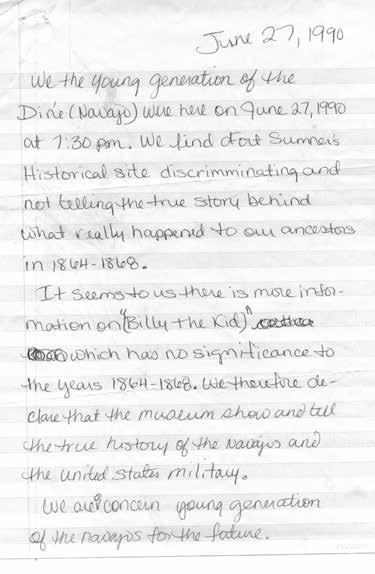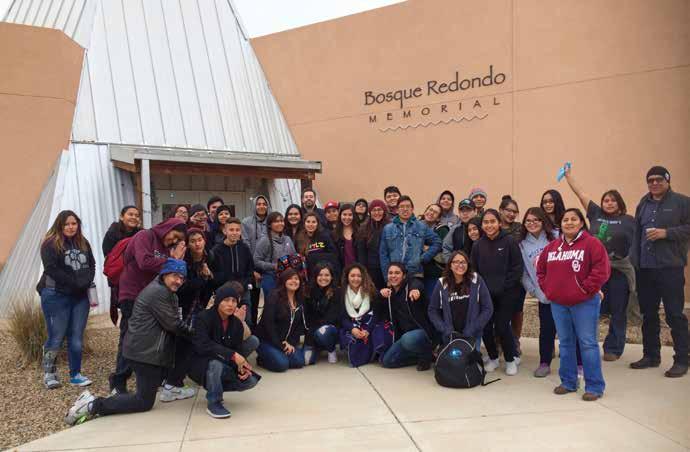
3 minute read
NEW MEXICO HISTORIC SITES
Top: A 1990 letter from Diné students inspired the creation of the Bosque Redondo Memorial at Fort Sumner in 2005. Bottom: Churro sheep, grazing alongside a llama at the Fort Sumner Historic Site/Bosque Redondo Memorial, are donated by the site to the Navajo Nation. Photos courtesy New Mexico Historic Sites.


Letter of Truth Renewal at Bosque Redondo
On June 27, 1990, a park ranger found a letter at Fort Sumner Historic Site. It was written on two sheets of ruled paper torn from a student’s notebook and signed by more than a dozen Diné student visitors to the site from Arizona and New Mexico.
It declared: “We find Fort Sumner’s Historical Site discriminating and not telling the true story behind what really happened to our ancestors in 1864–1868. It seems to us there is more information on “Billy the Kid” which has no significance to the years 1864–1868. We therefore declare that the museum show and tell the true history of the Navajos and the United States military.”
The letter compelled the 2005 opening of the Bosque Redondo Memorial, which commemorates the forced relocation of Navajo and Mescalero Apache people from present-day Arizona to the Bosque Redondo Indian Reservation during the 1860s. Now, 15 years after the memorial’s establishment, the Native students’ hastily penned protest is still inspiring programming there.
This summer, the historic site recognizes the 30th anniversary of the letter by continuing work on a new permanent exhibition Bosque Redondo: A Place of Suffering, A Place of Survival. Even after it opens (at a date yet to be determined), the exhibition “will never be finished,” according to its text panels. The intention is to invite further conversations with and contributions from “the communities directly impacted by what happened at this site.”
Curatorial decisions for the exhibition reflect three years of conversations between site staff and tribal partners, “over a year of which was just learning how to have a conversation,” says Fort Sumner site manager Aaron Roth. He says that unfinished quality is a hallmark of the ethos at Bosque Redondo, and visitors are encouraged to continue the Native students’ act of questioning and reinterpreting history.
“The first thing you are going to see when you enter that exhibition is the letter,” Roth says, emphasizing its continued significance. The site’s interpretive plan leans on oral history, which aligns factually with over 13,000 archival documents that, as Roth admits from a curatorial standpoint, “lack any type of humanity.”
The exhibition will offer visitors the personal perspectives of those who were impacted by the reservation and the journey there. Each gallery will feature quotes from oral histories in Diné, Mescalero Apache and English. The focus is interactive. Visitors will be able to digitally flip through the Treaty of Bosque Redondo and probe the different motivations of the individuals who signed it.
Navajo students from Ms. Mildred Chiquito’s Native Language class at Albuquerque’s West Mesa High School on a recent field trip to the Bosque Redondo Memorial. Photo courtesy New Mexico Historic Sites.

“This is not a stagnant history,” Roth emphasizes. “It’s still very much alive.” That concept will be embodied in a central storytellers’ room, where visitors can listen to 30 minutes of oral histories read by Navajo and Mescalero Apache voices. Another room will explore the aftermath of what happened when the narrators’ relatives left the Bosque Redondo in 1868.
Roth grows more animated in talking about private donor opportunities to contribute to the exhibition’s completion. Funding is needed for a formal exhibition opening with refreshments, traditional Native dances, craft vendors, and a kids’ corner with interactive art and archaeology lessons.
Private funding is also needed to bolster the ongoing Churro sheep program at the site, where the surplus of a flock is annually donated back to the Navajo Nation to support weaving and husbandry traditions. The Bosque Redondo team aims to grow the size of the current flock from 27 sheep to 75, with 25 to 30 sheep a year being donated to Diné families.
Recently, one family gave the site a wool blanket woven from a donated sheep. That simple gift underscores the strong regenerative possibilities of the Bosque Redondo, a place where both written and living histories experience renewal.
Plans for future exhibitions, though current as of April 30 press time, are subject to change.










